Photo: A breeder male Gold OB Peacock in a five-gallon bucket as he is being processed before being moved back into his breeding colony.
WARNING!!! This is a rather long and geeky fish blog for my fishkeeping friends. I decided to kill two birds (or fish, whatever!) with one stone by 1) talking about a neat Peacock Cichlid we developed and raise and 2) to respond to requests for how we do things in the hatchery.
We have been trying to catch up on processing our cichlid breeding colonies, a difficult task since we are short staffed due to the coronavirus.
This week we processed one of my favorite Peacocks, Gold OB Peacock. Unlike many Peacocks, Gold OBs have somewhat colorful females, and I intensify this by selecting for color when picking female breeders.
OB Genetics: OB, which I think originally meant “orange blotch” is a dominant gene (technically allele) causing any fish carrying it to be blotched. I’m not sure why it was called orange, since the blotching is usually black. The amount of and size of blotching is determined by modifying genes. The male fish above is OB, but has modifying genes that have reduced the amount of blotching.
We developed our Gold OB Peacocks beginning way back in 2005. Here is a brief history of the strain:
- July 15, 2003 Hurricane Claudette surprised us. Claudette at dawn that day was a tropical storm; but by 10:00 a.m. it had churned up into a category 2 hurricane with winds of 113 mph (~182 km/hour). We were caught unprepared. Our single greenhouse, today’s Greenhouse 1, was rated for 80 mph (~129 km/hour) winds. At dawn Claudette, as it moved to come onshore, had 70 mph (~113 km/hour) winds. We are inland about 30 miles (~48 km), and I expected the storm to weaken before reaching us. Wrong! Claudette quickly intensified. As it approached, we experienced hurricane-force winds, but they were blowing parallel to the long axis of the greenhouse. I stood in the greenhouse; it shuddered but held up. I thought we were safe. Unfortunately, the storm’s eye didn’t cross us; it slipped off to the south and the winds shifted from out of the south to out of the east, broadsiding the greenhouse. By early afternoon, the greenhouse had caved in, air and water lines were broken, and water pumps, blowers, and the greenhouse heater destroyed.
- Over the next few days with summer heat and without air and moving water we could only try to save the fish by dumping them from vats into the floor gutter (the floors of our greenhouses are water about six inches (~15 cm) deep) and into the four-foot deep sump. At the time we raised primarily rainbowfishes, some sailfin mollies, and one cichlid (Labeotropheus trewavasae Redtop Blue). Losses were staggering.
- Rather than take the time to raze the greenhouse and rebuild on site, we built what is now Greenhouse 2 next to it and left the razing for winter. We completed Greenhouse 2 by October 2003, just in time to move the surviving fish into it before cold weather hit.
- Greenhouse 2 with its 400 55-gallon vats was virtually empty even after moving the surviving fish into it. Needing revenues to help pay for lost inventory, lost sales, the costs of building and equipping Greenhouse 2, and the later rebuild and equipping of Greenhouse 1, we decided to place breeding stock orders with EkkWill and Segrest fish farms in Florida. We bought what was available, mostly a wide variety of cichlids and livebearers many of which we still raise today.
- One of the fish we got was a box lot (about 250 small fish) of OB Peacocks from Segrest. These fish were a motley lot. We raised them up over the winter, selected a few best males and set up breeding colonies in the rebuilt Greenhouse 1. Surplus males were sold, bringing in needed revenue.
- From that box lot of fish, we developed many Peacock strains. One early strain was our Blue OB Peacock, which remains one of our most popular cichlids today. By 2005 we had improved and stabilized the Blue OBs, but still got some offspring that were not of type. These fish were segregated by color and new breeding colonies were set up. From these colonies we set up in 2005, we developed our Blue Peacocks, Orange OB Peacocks, Particolor OB Peacocks, Skyblue OB Peacocks, and the topic of this blog, Gold OB Peacocks.
- The best Gold OB males were given females and selection for improved color began. I found that while dull grayish OB females produced the best Blue OB and Particolor OB males, pale OB females the best Skyblue OB males, and orange OB females the best Orange OB males, it was gold OB females that made for the best Gold OB males. (As an aside here, I discovered when raising fancy guppies as a teen that it was important to know which females of a strain produced the best males of that strain. When working to improve a strain, females are just as important as males.)
- Today, we continue to raise descendants of those Gold OB males we selected long ago in 2005.
Okay, history is out of the way. Well…not quite. In 2017 Hurricane Harvey struck. By that time, we had three greenhouses. Having learned from Claudette, before hurricane force winds could strike, we removed the plastic film covers of the greenhouses allowing the winds to blow through. There was much damage, but the structures were saved. See my blog: https://goliadfarms.com/hurricane-harvey-recovery-september-12th/ for running posts during and the days immediately after the storm. Recovery has been slow as residual damage continues to show up. Just as we began to think we’d soon see the end of that disaster, COVID-19 struck. Susie (wife and tyrannical business manager) and I are full time employees of Goliad Farms™ and we have three part time people. Unfortunately, two of them have school age children and have been able to work only a bit. Another has also had to reduce hours. So, we’re limping along with Susie and me doing most of the work while renovating Greenhouse 2 and preparing a complete rebuild of Greenhouse 3, both necessitated by significant Harvey damage. Fish production has suffered as a result, exacerbated by the loss of our awfully expensive greenhouse heaters in the storm. Rainfall of 14” (~36 cm) destroyed their electrical components. They were replaced with smaller heaters that kept the fish from dying of cold, but didn’t keep them warm enough for good winter-time reproduction. Unfortunately, it isn’t feasible (as in not at all possible) to get insurance in Texas for our greenhouses and their contents, including livestock.
So, due a late start because of everything else we were doing, it was with some trepidation that we tardily started our springtime processing of cichlids. We try to process all the breeders we set up the last fall by early April of the next year. If we wait too long, we lose some reproduction since the older fry get large enough to eat their smaller brethren. We are about a third of the way through this spring’s processing now that we’ve reached the Gold OBs. How do we “process” cichlids? After describing how we keep a particular group of cichlids: breeders, sale, and potential breeder fish, I’ll give a step-by-step description of processing.
Each cichlid species or strain usually has six vats dedicated to it. At the beginning of a breeding cycle, which lasts three to four months depending on the time of the year, there are these vats:
- 55-gallon vat with 1-2” fish
- 55-gallon vat with 2-3” fish
- 55-gallon vat with 3-4” fish
- 55-gallon vat with adult females
- 55-gallon vat with adult males
- 300-gallon with the breeding colony
Typically, we aim for these vats to hold about 150 1-2” and 2-3” fish, about 75 3-4” fish (which we hold as future males and females to sell and from which we select replacement breeders), around 100 females, and 100 males. Depending on the numbers of 1-2” and 2-3” fish, sometimes those two vats are combined.
Processing steps:
- Print out a report from our database for in this case Gold OB Peacocks, showing their vats and expected inventory.
- Net the males out of Vat 5 with a 19-inch (~48 cm) round net and place them in a 5-gallon bucket at the front of the greenhouse. Place a siphon in the vat and allow the water to siphon into the floor gutter.
- Sort and count the males.
- When the siphon breaks, clean the vat with a 10” brine shrimp net. This gets any debris and fine particles out of the vat. Usually this is not necessary if there are enough fish in the vat. They keep it stirred up and the debris runs out the vat’s overflow. Typically, 50-100 gallons (~198-379 liters) of water pours into the vat per hour.
- Return the males to Vat 5.
- Repeat steps 2, 3, and 4 for Vat 4 to process the females.
- Return the females to Vat 4.
- Repeat steps 2, 3, and 4 for Vat 3 to process the 3-4″ fish (which we call “BRUs” for potential “breeders, unsexed”, into Vat 3.
- Sort these previously unsexed fish into males, females, and unsexed (BRUs). Set aside any potential breeders. Place the remaining fish into their proper vats.
- Repeat steps 2, 3, and 4 for both Vat 1 and Vat 2. Size sort these fish into 1-2”, 2-3”, and 3-4” (BRU) fish and place them back into the proper vat for their sizes.
- Remove the fry cages and cichlid hotels (I’ll describe these below) from Vat 6, the 300-gallon breeding colony vat. Net out as many of the fish as possible.
- Siphon the vat to empty it.
- While the vat is siphoning, sort the fish into 5-gallon buckets by breeder male (BRM) and breeder female (BRF) and offspring 1-2”, 2-3”, and, 3-4”. There are usually no 3-4” fish unless we are running late in processing them.
- We don’t clean the 300-gallon vat since we usually have two to three large plecostomus (around 20” [~50 cm] long) in the vat as janitors. They keep it clean.
- Set up the breeder vat, placing two fry cages and 6-8 cichlid hotels in each. Fry cages are 24” (~61 cm) cylinders with a bottom of ½” (1.3 cm) aquaculture mesh netting and three or four PVC legs so they stand off the bottom of the vat (see photo below). These fry cages provide shelter for fry and for the feeder guppies we polyculture with the cichlids. You’d be surprised at how well guppies do with cichlids. Cichlid hotels are six 12” (~30 cm) long 2” (~5 cm) cylinders of ½” (1.3 cm) mesh fastened around a 12” (~30 cm) 2” (~5 cm) PVC pipe (see photo below). The pipe provides ballast to prevent the hotels from floating. We also make cichlid hotels from 3″ (~7.6 cm) or 4″ (~10 cm) flexible black drain pipe, which are also weighed down by 2″ PVC (see photo below). The hotels provide cover for females and juveniles. Each 300-gallon breeder vat is equipped with 1) two fry cages, each with two cichlid hotels inside them, 2) six regular cichlid hotels, and 3) one large pipe hotel. These hotels are suspended along the sides of the breeder vat (also see photos below).
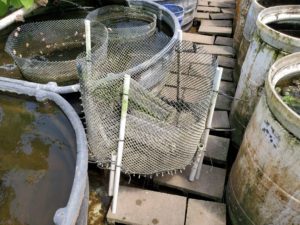

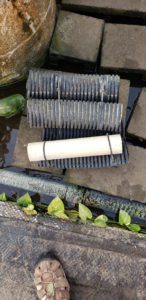
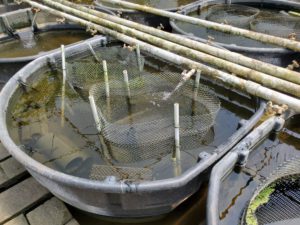
Results of our processing this cycle:
We had recently sold out of Gold OB Peacock adults, so we had none. Here’s what we ended up with:
Quantity Size
102 1-2”
127 2-3”
151 3-4”
The 3-4” fish were mostly from the previous cycle, so our breeding colony produced only about 230 fish. This is less than half of what we expect. Why such low production? Two main reasons:
- We lost production due to predation. The youngsters were left too long in the breeding vat and their younger siblings became food.
- Wintertime temperatures were too low. Because of the loss to our large heaters during Hurricane Harvey, we had to purchase and use of smaller, less effective heaters. They struggled to maintain temperatures above 70°F (~21°C) during cold, cloudy periods. As long as daytimes are clear and sunny, we don’t have to heat. The water gains enough heat during the day to keep the water temperatures toasty until morning and more solar gain. But we often get several days of cold, cloudy weather and the water’s warmth bleeds off and we must heat. Last winter had too many cold, cloudy days. Low temperatures meant the fish didn’t reproduce and growth slowed to a crawl. Fish that grow an inch (~2.5 CM) a month during the summer barely grew last winter.
We hope our cichlid production will return to normal during the summertime breeding cycle.
Sexual Dimorphism in Peacocks
A few words about Peacock sexual dimorphism:
First, what is sexual dimorphism? Well, what is dimorphism? In Latin, “di” means two and morph means shape or form. So, dimorphism means two forms. Sexual dimorphism refers to the fact that many animals have two different forms based on sex. In humans, larger size, beards, and lack of breasts are male characteristics. While small size, no beards, and large breasts are female characteristics. Similarly, male Peacocks are larger, more colorful, and have different head structures than female Peacocks.
Looking at the two photos of two of our breeders, male in the top photo and female in this photo, illustrates Peacock sexual dimorphism.
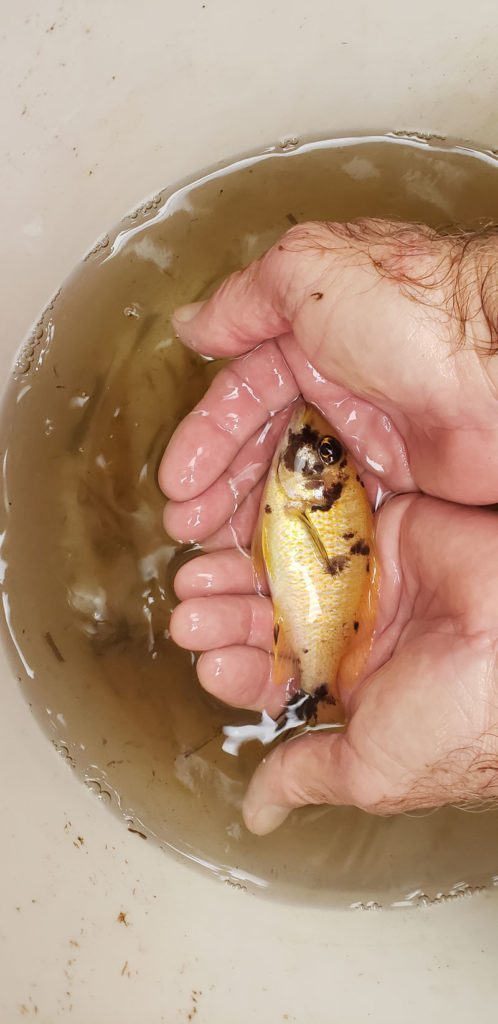
Size: As you can tell from the photos, our breeder male is much larger than the pictured breeder female which is roughly the male’s age. She is typical of our breeder females. We allow our females to carry eggs and never strip so they tend to grow a lot slower than the males. Our for-sale females are often larger since they are segregated from males and aren’t reproducing.
Color: The male is also more colorful.
Fin Shape: The male has pointed dorsal and anal fins while the female has rounded and less colorful fins.
Head Shape: The male has a higher forehead than the females. This characteristic can be enhanced by selection, which we have done in our Dolphin Cichlid lines (see blog: https://goliadfarms.com/particolor-dolphin-cichlid/).
Behavior: While the photos can’t show behavior, the two sexes are quite different in behavior. In our 300-gallon breeder vats the males establish mating stations, usually in open spots, jousting with each other for the best sites. The females cluster together away from the males and tend to remain near cover.
One final thought: as I select for more colorful females, we find it more difficult to sex out young fish. But, in the long run problem seems acceptable in order to get more colorful females.
Well…one more final thought:
OB Peacocks are hybrids. Of what I’m not sure. I’ve read reports that they are hybrids of Aulonocara sp. and Pseudotropheus zebra. I’m not sure about that. But, it doesn’t matter; it’s clear they are either aquarium strains or hybrids or, mostly likely, a combination. Hybrids are controversial. Some purists rail against any hybrids. Others point out the hobby is built on hybrids. Think fancy swords and platies, all hybrids of various Xiphophorus species, and commercial mollies, all of which are hybrids of Poecilia species. Also, don’t forget the fantastic Discus that breeders like Jack Wattley developed. My position is the hobby is large enough to fit both pure species and hybrids. We raise both. We are diligent about keeping pure species pure and hope everyone else does too. The important thing is labelling. Only fish that are pure should be labelled with scientific names. Hybrids and fish from aquarium strains of dubious origin should be labelled only with common names. For those who subscribe to our Newsletter I’ve started a series on hybrids, which is sure to annoy some. As always, I encourage questions and comments. Please keep it friendly.
Good fishkeeping!
For more information about our OB Peacock cichlids, see these blogs:
https://goliadfarms.com/blue-ob-peacock-cichlid/
https://goliadfarms.com/gold-ob-peacock-cichlid/
https://goliadfarms.com/orange-ob-peacock/
https://goliadfarms.com/skyblue-ob-peacock-cichlid/
https://goliadfarms.com/canary-ob-peacock/
https://goliadfarms.com/our-peacock-cichlids/
For information for some other Peacock cichlids we raise, see these blogs:
https://goliadfarms.com/blue-peacock-cichlid/
https://goliadfarms.com/dragon-blood-peacock-cichlid-genetics/
https://goliadfarms.com/dragon-blood-peacock/
https://goliadfarms.com/non-gold-dragon-blood-peacock/
https://goliadfarms.com/dragon-blood-peacock-cichlid/
https://goliadfarms.com/lemon-peacock-cichlid/
https://goliadfarms.com/blue-empress-peacock-cichlid/
https://goliadfarms.com/shop/sunshine-peacock/

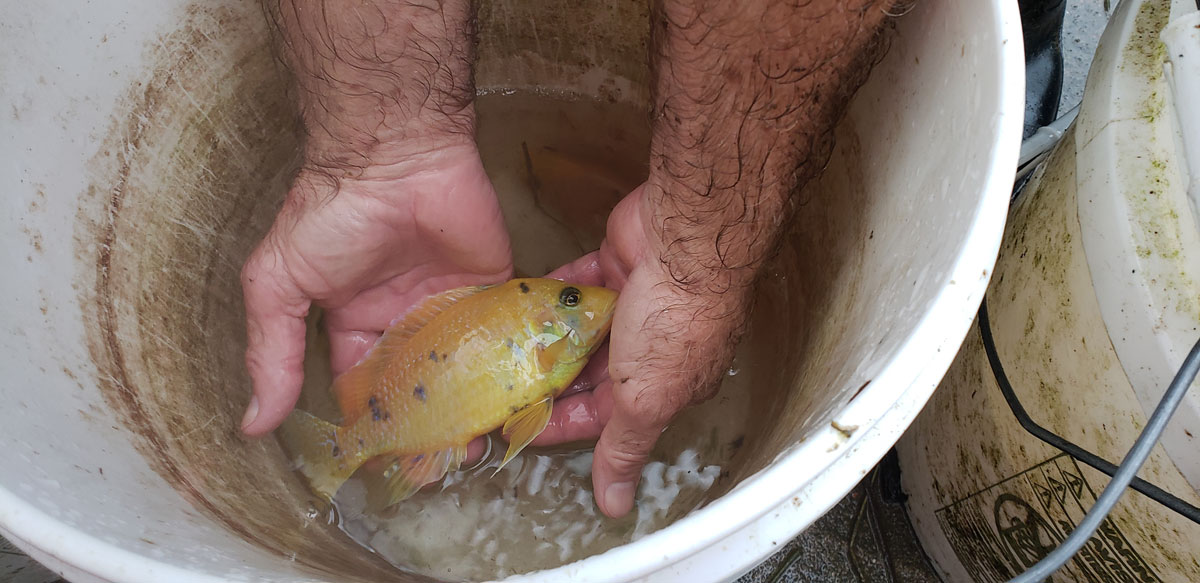
Leave a Reply